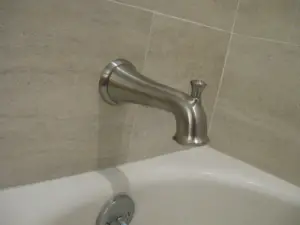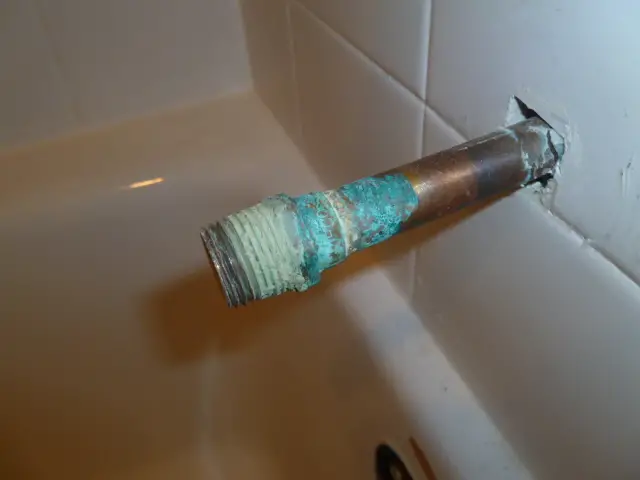It’s essential not to overlook tub spout pipe length as you design your bath tub; that’s why determining that is of utmost importance. You will likely prioritize things like the vanity, tub, flooring, and tile work when remodelling your bathroom with fixtures like tub spout coming secondary.
Does tub spout length matter? Yes it does and the tub spout pipe’s length depends on the type of tub spout you have. For instance, the copper pipe of a slip-on tub spout should be at least 1 inch and utmost 2 7/8 inches long, but you must consider the tub spout you have.
When fixing a new spout, it’s paramount to put together a pipe or measure and purchase the right length. This is because the depths of the plumbing behind your wall differ, and spouts are available in different sizes.
Making sure everything is installed correctly will save you from many problems in the long run, including leaks that can stain the area, causing water damage.
Does Tub Spout Pipe Length Matter?
Before buying and installing, check the manufacturer’s specifications to make sure you get the correct length. If you want to put a faucet in a shower unit and tub combination, the tap is typically placed low, which is 12” to 18” above the bathtub rim.
On the other hand, the tub spout usually sits 4” above the tub rim, while the faucet is 48 inches above the bathroom floor in a unit with only a shower.
Measure the reach of a tub spout by determining the tub spout length from its back edge to where the threads begin on the spout inside. Also, take the length from the wall surface to the threaded elbow back inside the wall, then add the two plus a ¼ inch.
Almost all shower and tub faucets need cold and hot water supply pipes of ½ inch in diameter. In addition, the spout nipple should be fixed at a minimum of 3/8 inches to a maximum of ¾ inches beyond the finished wall.
How Far Does Tub Spout Stick Out?

A tub spout sticks out to the recommended length that is given in the installation manual of your particular spout. However generally the spout should be installed a minimum of 3/8″ to a maximum of 3/4 inches from the finished wall.
After installing the nipple for the spout, you will screw on an adapter onto the nipple. Finally the spout slides on the adapter and is set in place with a screw which is located at the bottom of the spout, allowing for proper orientation of the spout.
Read also How to fix tub spout not flush with wall
Are there Different Types of Tub Spouts?
Tub spouts are available in different types categorized based on their appearance, installation procedure, functionality, material, and size. Here are the main types of bathtub spouts.
1. Slip-On Bathtub Spouts
These types of spouts connect to the line supplying water using a screw found at the spout’s bottom. Off all the tub spouts, these are the simplest to install and remove, with the only tool you will need for the job being an Allen wrench to help tighten or loosen the screw.
They are ideally attached to ½-inch copper water supply pipes of appropriate length and burrs/dents free. Therefore, be careful when removing your old slip-on bathtub spout to avoid damaging it, thus making the pipe burred and, in turn, causing leaks.
You will require a 1 to 2 7/8 inches long pipe for a slip-on tub spout.
See also Ways to fix tub spout that is too short
2. Thread On Tub Spouts
They are also called screw-on spouts and have threaded pipes instead of using a screw. When removing and installing this spout, you must be careful in order to ensure the wrench doesn’t chip off the finish or strip the threads.
Threaded bathtub spouts are available in the following categories:
a) Telescoping Tub Spout
As its name suggests, you can adjust up to one inch from your finished bathroom wall; hence you can bring it closer or further from the wall as long as you maintain the 1-inch range. Moreover, it connects to ¾ or ½ nipples.
b) Front End Threaded Bathtub Spout
You can use this spout in a bathtub valve that doesn’t have a shower or if the shower diverter is built into the bathtub valve.
c) Rear Threaded Bathtub Spout
It’s also called a wall-ended tub spout, and it’s more versatile compared to its front-end threaded spout counterpart. You can join it to a ¾ or ½ inch stub-out nipple at the spout wall end.
In addition, you can use a rear threaded tub spout with a secondary outlet, allowing hand-held showers use or a standard shower diverter.
c) Diverter Tub Spout
You will see diverter tub spouts in shower-bathtub combinations. It has a mechanism that permits the upward flow of water, which in turn provides sufficient pressure to run the shower.
Pushing the knob down opens the shower diverter, letting the water out of the tub spout. If you want the water to flow via the showerhead, pull up the knob.
The water pressure is responsible for keeping the shower diverter up, so without sufficient pressure, it will drop, making showering impossible.
This tub spout features a button attached to the floor or one that’s held up that creates the water diversion from the bathtub to the shower. You will find diverter tub spouts in various finishes, styles, and polishes.
They are made of different materials, such as aluminium, brass, and chrome. What you choose will depend on your aesthetics and design style, with ones with fancier or more exotic materials costing much higher.
The shower diverter will get stuck after many years of use, debris and mineral deposits, corrosion, making it hard or impossible to pull it down and up. While you can fix a malfunctioning diverter tub spout, replacing it provides a more efficient, long-term solution.
See also Toilet ring placement ideas
d) Non-Diverter Bathtub Spout
It’s connected to tubs where water only flows out via the spout and is not diverted to the showerhead. Furthermore, it doesn’t have a knob located at the top.
Non-diverter tub spouts are fixed in bathrooms with two faucets (one for the showerhead and the other for the bathtub). The style is common in modern or re modelled bathtubs.
e) Soldered Bathtub Spouts with Adapters
Sometimes the adapter of a tub spout is soldered instead of being screwed or threaded. A bathtub spout that has a soldered brass adapter isn’t easy to install or remover, and it’s not ideal for everyone.
You will require a torch to do the job, although some recommend a hairdryer as well, but the former is the most suitable tool. Additionally, ensure you know how to safely use a torch.
You can quickly remove or install this tub spout if you have the necessary expertise, but beware that some things can go wrong. This is why most people opt to hire a professional plumber.
See also Can you put faucet on side of sink
Conclusion
You can now tell that the correct tub spout pipe length doesn’t exist since the plumbing sits in different depths in various houses and tub spouts come in different sizes. If you are up for a project, you can make your own pipe, or visit your local store to buy one.

